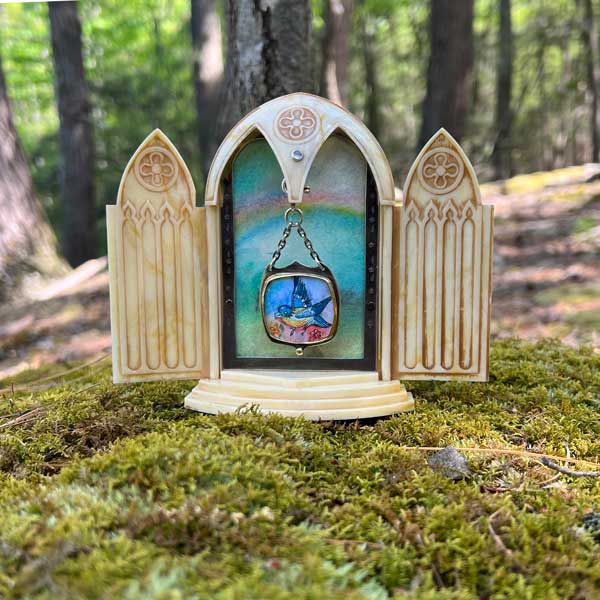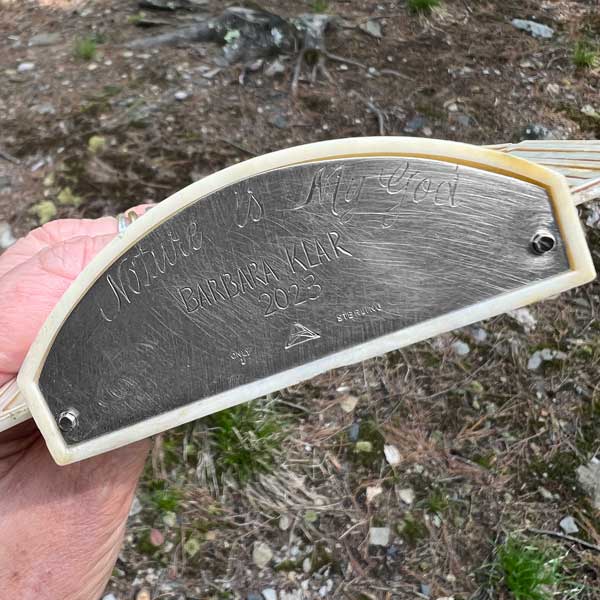Wednesday, May 17, 2023
Why I make Reliquaries
Tuesday, January 24, 2023
Historical Inspiration and my obsession with Mansions
As I roamed these hallways with fascination, I imagined the workers who created this masterpiece of architecture and design. Who were they? Where were they? How did they make this?
Not only did my curiosity become inspired, but I learned to meditate. Unity installed a bio-feedback machine where we learned to take the power of the mind over the body. We studied the Bible yet not in a literal way. At 7 years old I was smacked in the face on the playground by another child when I announced “Jesus was not real”. He was only written to convey “the ideal human” in a book of fiction.
I am expanding here because I want to emphasize how important it is to follow the signs on a path. The journey is the meaning. I may have developed a love of craft in this mansion but it was my ability to learn to control my mind through meditation that stabilized me on the journey for which I was never fully prepared. My journey forward resembled falling off a cliff without a parachute. As a child, I had nightly dreams of falling over a cliff as it wrenched me from the depths of sleep into a panicked, sweaty fear. I learned to combat this when I trained myself to imagine gently falling into a pile of hay when I fell off that cliff in my twilight travels. The dreams stopped. Fear, however, did not. It never does.
Some drawer pulls of my own design, below:
Thursday, March 11, 2021
The Broken Plate
The most meaningful part of my journey as a jeweler and metalsmith are the pieces I make that reflect a period in time that represent someone else's journey. These are pieces that incorporate history, memories, and emotions. These opportunities are the gift of my work and I am constantly amazed what I learn about people and what I am blessed to creatively express.
When my friend Cherie approached me about making a brooch from a broken plate, I had not idea about the backstory of this broken plate. Here is her story:
 |
Friday, February 26, 2021
Tiaras
I don't know why I've always been obsessed with Tiaras. Perhaps being a princess is every little girl's dream. Often I found myself gazing at Jesus's crown of thorns or an angel's halo. The first Tiaras I made were in 2002 when I was invited by Fragments to premier my wedding band collection in their Madison Ave. store. I thought if I put some awesome tiaras in their windows, it would generate business. I created The Glenda tiara from the good witch on Wizard of Oz, the Athena Tiara which represented the Greek Warrior Princess,and the Gabrielle Tiara inspired by Xena Warrior Princess.
When I recently read M.J. Rose's new book, entitled "The Last Tiara", I pulled out the photos of my Tiaras and realized I was yearning to be a part of the "Tiara Tradition" since long ago. If you love historical fiction as much as I do, I urge you to read her book which is based on a lost tiara from the gems of the Romanoff Russian jewels.
"Glenda" tiara,
vermeil, moonstones and cz's
AND THEN: How could I resist the temptation to make stainless crowns for my dog CoCo and my cat Jessie? They were my Queens!
Tuesday, October 13, 2020
The Journey of the Balangandan Necklace
During the Covid-19 Lockdown, I was talking with a fellow jewelry designer, and she began telling me about an amazing piece of history, the Balangandan Necklace. (Read more). The Balangandan originated in 17th century, and was worn generally in 18th and 19th century by Brazilian women of African descent. It can be worn at the waist, as a necklace, a bracelet, an amulet, or used as a door hanging. The Balangandan are primarily made of copper, gold or silver, with hanging charms that are meaningful in the wearer's life. Some charms are spiritual, representing African Orishas or Christian dieties. Others are meant to impart good fortune, or to commemorate important life events. As I bean researching the Balangandan, I found the images below, and was struck by the pride and power of these women. I'm not sure if they were enslaved. Had they been born in Africa? Did they have children, husbands? What were their lives like, what were their hopes and dreams? Had they been transported 3000 miles against their will, never to see home and family again? That very prospect sent chills up my spine and I spent the evening looking out the back window of my house at the trees and starlight and COVID darkness. I held the Mother of Pearl Charm that I'd purchased 25 years ago at a flea market in my hand. I'm not sure of its age or origin, but it's always felt like a tranformational piece for me. And at that moment I was inspired to begin work on a Balangandan of my own. I've always been intrigued by charms, their beauty and meaning. I wondered at passages and changes in my own life and the significant things, both physical and emotional that I've accumulated over the years.
I created my 2020 version of a Blangandan to exemplify an eternal reverence to the hopes and dreams of women everywhere. I built the piece around the central Mother of Pearl charm and made the chain links to represent barbed wire, the horrors of chattel slavery, and the extraordinary perseverance and strength of the women who survived. I chose opals and moonstones to honor our hopes and dreams: the things we wish for and the reality of our everyday lives. I adorned the corners of the silver plate with Aladdin's lamps to inspire magic.
All the charms represent a woman's journey: children, growth and daily tasks, emotional and physical strength, love, and loss on a life's path well-traveled. Some of the charms are vintage and some of them I made. Each individual charm has a meaning to the concept of the piece.
The Balangandan can be worn on the neck or at the waist. It can also hang on a wall by the front door, as it often did in 19th century Brazil. It is my intent that the owner adds their own charms to commemorate their individual soul's journey.
Sunday, April 5, 2020
This is my studio mascot: Mr. Don’t Panic. I bought hin from a street artist on 8th St. in NYC in 1988. He’s been in every studio I’ve had since then. I always say that it takes about seven years for a jeweler to develop a vocabulary of skills: the things you know to fix when you tend to f*ck up a project. He holds that space for me and reminds me not to panic. He is especially valuable to me now during the challenging times we are facing now on earth. Do you have a personal talisman or mascot that gives you strength and stability? I’d love to know…
Sunday, September 30, 2018
Are you old enough to remember the commercial that ended with the tag line: “Only your hairdresser knows for sure?” I’d like to change that to: “Only your jeweler knows for sure”. Here is a lovely secret I recently shared with a couple on their 20th wedding anniversary.
Blair Breard was a friend in the early days of my first store, Clear Metals, in the East Village of NYC. She would come in, hang out and share her stories about her experiences in NYC as a young actress. She met Robert Leaver and they married. They are both incredible talents and human beings. (Blair now has her own production company, “Bossy Boots” and Robert is an artist, musician and performance artist
I made their wedding bands. They had a son, Mason (now a teenager). Twenty years later, they are still my friends and loyal customers. Twenty years is a long time. What does 20 years mean in a relationship? If you search for traditional gift ideas on google, it will say China, white porcelain. More to my liking it is represented by the color green or by the emerald. Think of growth and creation.
Robert came to me early on, perplexed by the idea of what to gift Blair for this big milestone. He was struck by the idea of going back to the altar in the woods where they had committed their vows, to see if there were any remnants underfoot he could repurpose into a gift. He came to me and showed me a handful of stones where they had been standing. Pepples, dirt and broken china. One pebble, not beautiful, came to represent how they had turned dirt and stone into a lasting, creative relationship. I put this pebble into a prong setting, melted some silver into a metal pebble and set an emerald into this blob of creation.
Together Blair and Robert created Mason. Blair had secretly kept all of Mason’s baby teeth because she had an inside relationship with the Tooth Fairy. She came to me and showed me a little tin filled with Mason’s teeth. Some were large, some were tiny. I created a “tooth charm” for Robbie. It is organic and strong, a symbol that is representative of creating something from nothing. How we all bloom. I hand carved the charm in wax and added gold to represent preciousness. I held my breath as I sent two UPS packages to the same address to each of them on the same day. I wondered how this would play out.
One of the perks of my chosen profession is that I receive the gift of sharing in these meaningful moments of life with people. Friends who become patrons. The most valuable lessons I’ve learned in all of this is how to keep secrets. And patience: the patience to wait until I hear from both, simultaneously, elated and filled with joy. I have such gratitude that I get to share in these special moments.







































